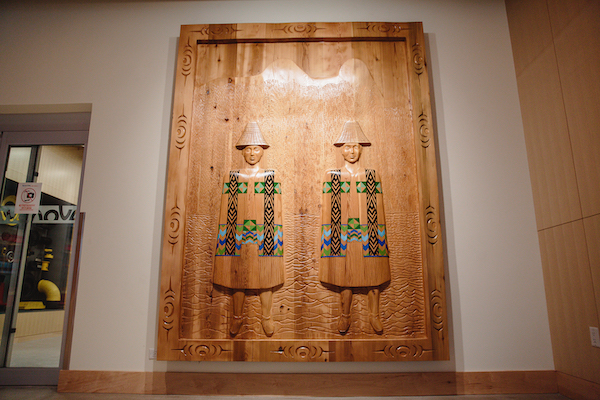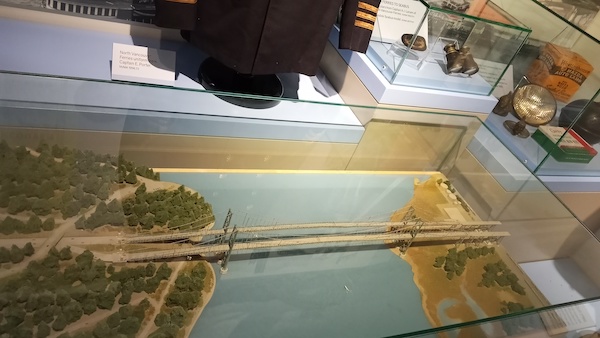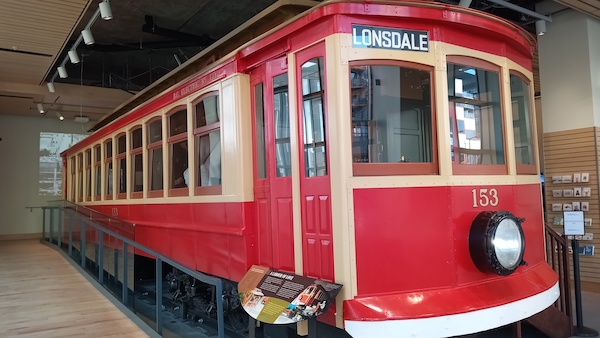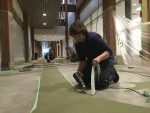Housed in the lobby of the Museum of North Vancouver, visitors can once more hop on Streetcar #153, which carried passengers along the Lonsdale Line from 1912 to 1946. (photo by Cynthia Ramsay)
This story took me a long time to write. Everything I read about the Museum of North Vancouver (MONOVA) set me off on another path of exploration. I’ve watched (really) old home movies, looked at countless archival photos, perused online exhibits – all of this after I was treated in December to a tour of the museum’s beautiful new space at 115 West Esplanade. Such is the seemingly never-ending amount of wonder the museum offers.
Days after the official opening on Dec. 4, curator Barbara Hilden walked me through the exhibits. I arrived early and had time to buy a few things in the gift shop – there are some excellent books, clothing, toys and other merchandise for sale. I also walked through the restored electric Streetcar #153, which carried passengers up and down the Lonsdale Line from 1912 to 1946, and admired Squamish (Sḵwx̱wú7mesh) artist Wade Baker’s cedar carving of Sch’ich’iyuy (the Two Sisters).
“The red cedar Sch’ich’iyuy panel is based on the ancient Sḵwx̱wú7mesh Sister’s Mountain Transformer legend,” says Baker on MONOVA’s website. “The twins were raised from childhood to be leaders for their people. They asked their father, the siyam, the chief, to bring peace to the warring tribes along the coast. He could not refuse their request and fires were lit all along the coast to signal a great welcoming feast to bring peace. For their efforts, the twins were immortalized in the mountain peaks you see today that watch over us.”

Beyond the museum lobby is a sparse area and a space for activities, a moveable wall separating the two. Visitors then walk through a corridor with images of trees on the walls, their branches continuing onto the ceiling. The Indigenous Welcome Circle, which highlights Squamish and Tsleil-Waututh (Səl̓ílwətaɬ) stories and items, is the anchor of the room. There is the notable presence and prominence of Indigenous involvement in the displays and, the day before the new museum’s opening, there was a memorandum-of-understanding signing ceremony that included members of the Tsleil-Waututh and Squamish nations.
“The MOUs affirm our commitment to working with Tsleil-Waututh and Squamish nations as equal partners,” Hilden told the Independent in an email interview after the tour. “MONOVA formed the Indigenous Advisory Committee several years ago to inform our programming, collecting, curatorial and operational activities. We rely on IVAC members to direct our strategic priorities in these areas and others, and to liaise with the nations. These needs do not diminish with opening our new location; on the contrary, their importance only increases. IVAC will continue to exist and we anticipate it growing larger and more robust as we look to incorporate Indigenous ways of knowing throughout the institution.”
Exhibits in the new permanent gallery include the Indigenous Welcome Circle, as well as themed displays – on sports, women in wartime, shipbuilding on the North Shore, and more. Interactive children’s displays help young visitors understand, for example, how to load a cargo ship and what various animals eat and what their poop looks like (this was a particularly fun exhibit, I must admit). An interactive map takes people through the history of the North Shore by water, trail, rail and road. Panels on one of the walls take us from the late 1700s to the present day with several photos and brief descriptions of notable events, good and bad, listed chronologically. There is a section – Truth and Reconciliation – dedicated to residential school survivors.
The museum’s first feature exhibition is called You Are Here @ The Shipyards. “It discusses the changing nature of North Vancouver’s lower Lonsdale area, from Indigenous settlement to working shipyards to contemporary tourist destination,” explained Hilden. “The exhibition features historic objects, archival photos and film … [and] will open in the spring of 2022 and run for one year. In the future, it’s anticipated that our calendar will be a mix of internally curated and traveling exhibitions.”
The North Vancouver Museum opened in 1972 in the old Pacific Great Eastern Historic Railway Station and moved to Presentation House in 1976, where it remained until last year. With the new location, came the new name, MONOVA.
“It’s taken more than 50 years, a multitude of meaningful discussions with community members and Indigenous leaders, countless volunteer hours, and painstaking research to amass a collection of more than 9,000 artifacts, but, after 20 years of planning, finally, the Museum of North Vancouver is ready to welcome the public,” reads the press release announcing the December opening.

In addition to the exhibits and activities that take place at 115 West Esplanade, there are many online exhibits. Archivist Dr. Jessica Bushey noted that two – Walter Draycott’s Great War Chronicle, and Climbing to the Clouds: A People’s History of B.C. Mountaineering – were created by the North Vancouver Museum and Archives, all departments working together.
“These were very large endeavours, taking nearly a year to create and involving consultants and partners,” said Bushey. “More recently, the archives team has focused on creating online exhibitions drawing upon archival materials that provide virtual access to the collections and offer a companion to on-site exhibitions at the archives building in Lynn Valley. These are smaller in scale, but strong in their interactivity and showcasing of archival photographs, moving images and oral histories.”
Currently, there is no specific Jewish connection in any of the material on display, but the museum is actively seeking additions to its collection.
“At the moment,” said Hilden, “we have materials exhibited from North Vancouver’s Ismaili, Iranian and Japanese communities. All the exhibits in our long-term gallery are designed to be flexible and changed out regularly, so we do anticipate updating and rotating these stories as more communities become aware of MONOVA and our desire to represent all North Shore stories.”
She said, “We would be thrilled to hear of more Jewish connections. We currently have very few tangible objects in our collection that would help us tell these stories, and I’d love to hear from members of North Van’s Jewish community.”
“The archives of North Vancouver is very interested in acquiring donations of archival materials from the Jewish community working, residing and thriving in the city and district of North Vancouver,” agreed Bushey, also noting the archives’ current lack of these materials.
“We have one file on Samuel Davis Schultz, who was a judge and alderman in North Vancouver and founded the honour roll of North Vancouver High School in 1912, a photograph of S. Schultz and a 2014 copy of the special issue of the Western States Jewish History quarterly journal, which focuses on the Davies and Schultz families. Lastly, we have the photographs from a City of North Vancouver 2000 millennium project on Diversity on the North Shore, which included the Jewish community and led to the publication From Far and Wide: Cultural Diversity in North Vancouver,” said Bushey.
“If anyone has archival records (e.g., correspondence, photographs, albums, diaries, home movies, business records etc.) they would like to donate,” she added, “they can email the archives with the particulars and we will get in touch.”
“MONOVA considers donations that have a close connection to the community of North Vancouver,” said Hilden. “The artifacts don’t need to be extremely old or extremely valuable to be considered. Sometimes, the most thought-provoking pieces are those that tell quotidian stories of everyday life. (Of course, the old and valuable belongings are welcome also!) We care for everything in our collection and, when we make the decision to acquire a piece, we commit to preserving, conserving and making it available for generations to come.”
To connect with the museum or archives, visit monova.ca.



